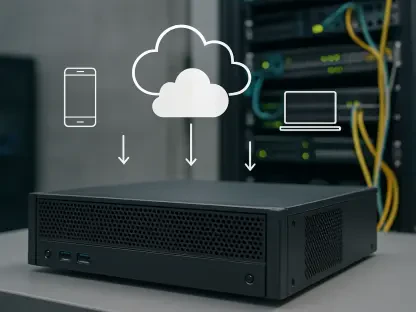In a digital landscape increasingly plagued by sophisticated cyber threats, ransomware stands out as one of the most destructive forces, holding data hostage and inflicting severe financial and operational damage on individuals and businesses alike. Google has stepped up to this challenge with the recent launch of an AI-powered security layer for Google Drive, introduced as an open beta for desktop users on Windows and macOS on September 30. This cutting-edge feature, available to both enterprise users of Google Workspace and personal account holders, marks a significant stride in fortifying cloud storage against malicious attacks. With ransomware becoming a pervasive issue that can cripple organizations overnight, the urgency for robust defenses has never been more apparent. Google’s innovative approach promises not only to mitigate these risks but also to redefine how cloud platforms protect sensitive information. By harnessing artificial intelligence, this tool proactively detects and isolates threats, offering a dynamic shield that goes beyond traditional security measures. The implications of this advancement ripple across individual users seeking peace of mind and enterprises aiming to safeguard critical data, positioning Google as a frontrunner in the ongoing battle against cybercrime. This development also hints at broader industry shifts, where predictive technology could become the norm in combating digital vulnerabilities, setting a compelling stage for exploring the intricacies of this new protective layer.
Unpacking the Technology of the AI Shield
AI-Driven Threat Identification
The cornerstone of Google Drive’s latest security enhancement lies in its ability to leverage artificial intelligence for preemptive threat detection. Unlike conventional antivirus tools that depend heavily on known malware signatures, this AI model excels in behavior-based analysis, identifying ransomware through subtle anomalies in file activity. Trained on an extensive dataset of millions of ransomware samples and continuously updated with real-time threat intelligence from VirusTotal, the system can pinpoint the distinct patterns of malicious behavior, such as rapid mass file encryption or corruption. This predictive approach ensures that even novel or zero-day attacks, which often evade traditional defenses, are flagged before they can cause significant harm. By focusing on behavior rather than static signatures, the AI offers a flexible and adaptive line of defense, capable of evolving alongside the increasingly sophisticated tactics employed by cybercriminals. This shift toward proactive identification represents a fundamental change in how cloud storage platforms can protect data integrity, ensuring users are safeguarded against both current and emerging threats with remarkable precision.
Moreover, the significance of this AI-driven detection extends to its integration within the Google Drive ecosystem, creating a seamless barrier that operates in the background without disrupting user experience. When suspicious activity is detected, the system doesn’t merely alert but takes decisive action by pausing synchronization to the cloud, thereby preventing the spread of corrupted files. This immediate intervention is critical in ransomware scenarios where speed can mean the difference between minor inconvenience and catastrophic data loss. The technology also minimizes false positives through continuous learning, refining its algorithms to distinguish between legitimate file modifications and malicious intent. For users, this translates to a reliable shield that doesn’t interfere with daily operations while maintaining a high level of vigilance. Such sophistication in threat identification not only enhances security but also builds trust in cloud storage as a safe repository for sensitive information, addressing long-standing concerns about the vulnerabilities of online data storage solutions.
Mechanisms for Isolation and Recovery
One of the standout features of Google Drive’s AI security layer is its rapid isolation mechanism, designed to contain ransomware before it proliferates. Upon detecting suspicious behavior, the system automatically halts synchronization between the local device and the cloud, effectively isolating the threat and preventing corrupted files from overwriting clean backups. This swift response is a game-changer, as one of the most damaging aspects of ransomware is its ability to spread through networked systems, rendering entire datasets unusable. By interrupting this process at the earliest sign of trouble, the AI shield ensures that the damage is confined to a limited scope, preserving the majority of data in its original state. This containment strategy reflects a deep understanding of ransomware dynamics, prioritizing the protection of cloud-stored information as a critical asset for both individuals and organizations relying on Google Drive for their daily operations.
Equally important is the recovery process, which has been crafted with user accessibility in mind. Google Drive’s versioning capability, which retains file versions for up to 25 days, allows users to revert to pre-attack states with minimal effort through a straightforward web interface. After the threat is isolated, notifications via desktop alerts and emails guide users step-by-step through the restoration process, ensuring that even those with limited technical expertise can recover their data without delay. This focus on ease of recovery reduces downtime—a crucial factor in ransomware incidents where every minute of disruption can translate to significant losses. For enterprises, this means business continuity is prioritized, while individual users benefit from a hassle-free way to regain access to their files. The combination of isolation and guided recovery underscores a comprehensive approach to ransomware defense, addressing not just the attack itself but also the aftermath, ensuring users can bounce back quickly and confidently.
User and Enterprise Benefits
Enhancing Individual User Protection
For everyday users of Google Drive, the introduction of this AI-powered security layer brings a newfound sense of security in an era where personal data is increasingly at risk. The system’s intuitive design ensures that individuals, regardless of their technical background, can navigate the challenges of a ransomware attack with ease. When suspicious activity is flagged, immediate notifications through desktop alerts and emails provide clear, actionable guidance on next steps. This user-friendly approach eliminates the intimidation factor often associated with cybersecurity incidents, empowering individuals to take control of their data protection. The ability to restore files to a pre-attack state via a simple web interface further simplifies the process, ensuring that personal documents, photos, and other critical files are not lost to malicious encryption. This seamless integration of advanced technology with accessibility highlights a commitment to safeguarding personal data without requiring users to become cybersecurity experts themselves.
Beyond the immediate response, the AI shield fosters long-term confidence in using cloud storage for personal needs. Many individuals hesitate to store sensitive information online due to fears of breaches or ransomware, but this feature addresses those concerns by offering a robust defense that operates silently in the background. The versioning system, which preserves multiple iterations of files, acts as a safety net, allowing users to experiment with file edits or recover from accidental changes without worry. Additionally, the continuous updates to the AI model ensure that protection remains current against evolving threats, providing a dynamic shield that adapts to new ransomware tactics. For personal account holders, this translates to a reliable platform where they can store memories, work documents, and other vital data, knowing that a sophisticated security layer is actively working to prevent loss or corruption. This balance of advanced defense and user-centric design marks a significant step forward in making cloud storage a trusted option for all.
Bolstering Enterprise Resilience
Enterprises, where the stakes of data breaches are exponentially higher, stand to gain immensely from Google Drive’s AI security enhancements. The financial and reputational damage caused by ransomware can be devastating for businesses, often leading to prolonged downtime and costly recovery efforts. This new feature directly tackles these risks by providing a proactive defense that detects and isolates threats before they escalate into full-blown crises. For IT administrators, the integration with the Admin console offers unparalleled visibility into security incidents, enabling them to monitor suspicious activities across the organization in real-time. Detailed audit logs further enhance this capability, providing a clear record of events for forensic analysis and compliance with internal security protocols. Such tools ensure that businesses can respond swiftly to potential threats, minimizing disruption and maintaining operational continuity even in the face of sophisticated cyberattacks.
Furthermore, the enterprise-focused aspects of this AI shield address the unique challenges of managing large-scale data environments. The ability to control and oversee recovery processes through centralized administrative tools means that IT teams can restore critical systems efficiently, reducing the window of vulnerability during an attack. This is particularly vital in industries like healthcare or finance, where data integrity and availability are non-negotiable. The system’s design also supports scalability, ensuring that as businesses grow and their data needs expand, the security layer adapts accordingly without compromising performance. By embedding such robust protections directly into Google Drive, enterprises are encouraged to adopt cloud solutions with greater confidence, knowing that their sensitive information is guarded by state-of-the-art technology. This not only strengthens their cybersecurity posture but also positions them to focus on core operations rather than constantly battling digital threats, marking a pivotal advancement in enterprise data management.
Industry and Market Dynamics
Shifting Competitive Landscapes
The rollout of Google Drive’s AI security layer positions Google as a formidable leader in the cloud security arena, potentially reshaping the competitive dynamics of the industry. With Alphabet Inc. at the helm, this innovation is likely to drive increased adoption of Google Workspace, particularly among enterprises prioritizing data protection in their digital transformation strategies. Competitors such as Microsoft OneDrive and Dropbox now face heightened pressure to develop comparable AI-driven security features or risk losing market share to a platform that offers superior protection against ransomware. This development could ignite what many industry analysts describe as an “AI security arms race” among tech giants, where the integration of advanced protective technologies becomes a key differentiator in attracting and retaining clients. As a result, users across various platforms stand to benefit from accelerated innovation, with enhanced security measures becoming a standard expectation rather than an optional add-on in cloud storage services.
This shift also poses challenges for traditional endpoint security providers, whose standalone ransomware solutions may see diminished demand as integrated defenses like Google’s gain traction. Smaller cybersecurity firms might need to pivot toward specialized niches, such as advanced threat hunting or tailored security architectures for hybrid environments, to remain relevant. Meanwhile, the broader market implications suggest a future where cloud providers are judged not just on storage capacity or user interface but on the strength of their security offerings. Investors and industry watchers are advised to keep a close eye on adoption rates of this feature and the strategic responses from competitors, as these factors will likely influence market trends over the coming years. The ripple effects of Google’s move could redefine how value is perceived in the cloud storage sector, pushing security to the forefront of business and consumer decision-making processes in a landscape increasingly defined by digital risk.
Setting New Industry Standards
Google’s proactive approach to ransomware defense through AI technology signals a potential turning point for industry standards in data protection. As regulatory bodies worldwide intensify scrutiny on cybersecurity practices in response to rising ransomware incidents, this feature could serve as a benchmark for what cloud providers are expected to offer. In sectors like healthcare and finance, where stringent data protection regulations are already in place, the adoption of similar AI-driven safeguards may become a compliance necessity rather than a competitive edge. This shift could prompt policymakers to mandate integrated security layers as part of broader data management frameworks, ensuring that businesses handling sensitive information are equipped to prevent and recover from cyberattacks effectively. Google’s initiative, therefore, not only addresses immediate threats but also lays the groundwork for future regulatory expectations, potentially influencing global standards over time.
Additionally, the broader industry trend toward embedding AI and machine learning in core platforms reflects a departure from reliance on standalone security tools. This movement suggests that comprehensive, proactive defenses will increasingly become an inherent part of digital services, rather than an afterthought or third-party add-on. For cloud providers, this means a race to innovate and integrate such technologies to meet rising user expectations for safety and reliability. The consensus among cybersecurity experts is that layered defenses, like the one Google has introduced, are essential for tackling the sophisticated nature of modern ransomware, which often bypasses traditional perimeter protections. As this technology matures and proves effective in reducing successful attacks, it may catalyze a wave of similar advancements across the tech sector, ultimately fostering a more resilient digital ecosystem where data security is prioritized at every level of service delivery.
Reflecting on a Milestone in Cloud Security
Looking back, Google’s deployment of an AI-powered security layer for Google Drive stood as a defining moment in the fight against ransomware, blending advanced technology with practical user benefits. This initiative effectively tackled the pervasive threat of data encryption attacks by isolating risks and facilitating swift recovery, setting a high bar for what cloud storage platforms could achieve in terms of protection. The tailored solutions for both individual users and enterprises demonstrated a nuanced understanding of diverse needs, ensuring that data safety was accessible to all. Market dynamics shifted as competitors were compelled to match this innovation, while the potential for regulatory influence hinted at a future where such defenses might become mandatory. Moving forward, the focus should be on continuous adaptation to counter evolving cyber threats, with stakeholders encouraged to monitor attack vector shifts and invest in complementary security measures. Exploring partnerships between cloud providers and specialized cybersecurity firms could further enhance protections, while users are advised to stay informed about recovery protocols to maximize the benefits of such tools. This advancement marked a significant step toward a safer digital landscape, urging the industry to build on this foundation for even stronger safeguards ahead.









